Weed Identification
Perennials 2
This is the second weed identification Perennial 2 page listing some of the common perennial broadleaf weeds.
You will find weed information including weed names and pictures, as well as, information on control.
This page contains information on Buckhorn Plantain, Broadleaf Plantain, Red Sorrel, Wild Violet and Common Yarrow.
Understanding Weed Identification Perennial Terminology
A "perennial" is defined as a plant that will live for two or more years. This means that perennials will not have to come back each year by seed. (Although many perennials reproduce by seed.)
No lawn is immune to weed problems, however, not all weeds can grow in lawns. The weeds that become established in lawns will be a type that can handle continuous defoliation through repeated mowing.
Method of Spread
Weed control begins with weed identification and understanding how weeds grow. Proper weed identification is important because different weeds may require different control techniques. Weeds, like grasses, can spread by seed, rhizomes or stolons and some can regenerate from root pieces left in the soil, common with dandelions.
Seeds - Some weeds are prolific seed producers.
Rhizomes - are underground stems which sprout at specific points and spread the plants.
Stolons- are above ground horizontal stems that also sprout at specific points along the stem.
Some weeds can be controlled without using chemicals, while others are almost impossible to control without them.
Many weeds don't like competition, so a thick lawn is your greatest defense against slowing weed growth.
Focusing attention on weed control without building a thick turf is a guarantee you will have continued weed problems.
The weeds listed on this weed identification page are not an exhaustive list and you may have other weeds common to your geographical area. Be sure to check with your local university extension office for specific conditions in your area.
Important Note: A mention of any herbicide is not an endorsement, but is only a list of commonly used and effective products. Different states, or even regions within states, may have specific laws pertaining to herbicide use or specific products.
Your local university extension office can be a great help in determining what products are available to you. Not all herbicides are available for homeowner use and the EPA is removing or adding herbicides frequently. Always use and store products according to instructions on the label.
Plantain, Buckhorn
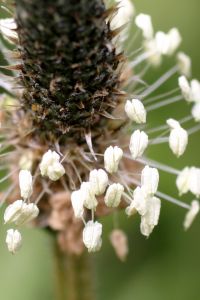
- Closely related to broadleaf plantain.
- Leaves begin in a rosette pattern and often curl upward.
- Leaves are dark green and slightly oval up to 10 inches long.
- Stalks are long and slender with a with a 1 inch seed head on top.
- Seed head stalks can be 6 to 24 inches tall.
Weed Identification
Buckhorn plantain is closely related to broadleaf plantain. It has a taproot instead of the fibrous root system like the broadleaf plantain. The leaves of the buckhorn plantain are 1 to 1.5 inches wide and up to 10 inches long. Leaves can lie flat on the ground or curve upward.
The easiest method of making a positive weed identification is to look for the long, slender stalk and bullet shaped seed head at the end. The seed head produces tiny flowers that protrude in a circle around the center. Because of these stalks, these plants can be difficult to mow. The mower deck pushes the stalks to the ground where they can lay flat below the mower blades for up to a minute after the mower passes by. It may take several passes with the mower to get them all.
Buckhorn plantains are slow to establish and are more common in poorly maintained lawns that receive little maintenance except for mowing. They are common in roadside parks, right-of-ways and other areas that are not well kept.
Cultural practices
These plants can be pulled up by hand. Over time they can be so numerous that pulling may not be practical.
Well maintained, thick lawns will rarely encounter any problems with buckhorn plantains. Properly maintained lawns become the solution for this weed as well as most other weeds.
Chemical control
Numerous broadleaf herbicides are labeled for control of buckhorn plantain. The single best time for control is in the fall. However, you can spray anytime the plant is actively growing.
Isoxaben is a preemergent product to prevent seeds from germinating and is to be applied in early spring. Dicamba plus 2,4-D is a good postemergent herbicide against established buckhorn plantain.
Plantain, Broadleaf
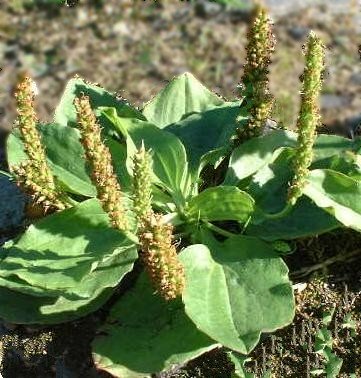
- Leaves are egg shaped in a rosette pattern.
- Leaves are much wider than Buckhorn plantain.
- Seed heads are on short stalks and resembles a rat-tail.
- Found in North America, east of the Rockies.
Weed Identification
Broadleaf plantain is a perennial weed with a fibrous root system. Its primary growth period is in the warmer months from June through September.
The leaves are egg shaped from 1.5 inches to 7 inches long and have several prominent veins that run parallel to the leaf margins. The leaves are wider than the buckhorn plantain which has narrow and long leaves.
Positive weed identification can be made by looking for a short, slender stalk with a long seed head growing up from the center of the plant. (Buckhorn plantain have long stalks with a short seed head.) Broadleaf plantain seed head is longer than other plantains and resembles a rat-tail. Tiny white flowers protrude horizontally from the upper half of the seed head. Plantains do not like competition and tend to grow in areas of thin turf. The primary method of spreading is by seed.
Cultural practices
Plantains can be removed by pulling them up by hand. Careful attention should be taken to remove the entire root.
Maintaining a thick, vigorous lawn is the best way to prevent plantains from germinating and spreading. This includes fertilizing as needed for your particular grass type and ensuring the soil pH is correct. Removing the plantains without correcting the problems that allowed for their growth will only ensure a future plantain crop.
Chemical control
Many post-emergence herbicides are labeled for broadleaf plantain control including herbicides containing dicamba as one of the listed active ingredients. Herbicide use can be hazardous if used improperly. Follow label instruction carefully when mixing, using or storing herbicides.
Red Sorrel
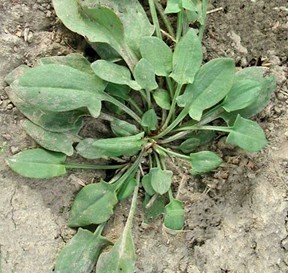
- Red sorrel is a sign of low fertility and acid soil.
- Arrowhead or fish-shaped leaves.
- Leaves become thicker over the summer.
- Produces both green and reddish-brown flowers.
Weed Identification
Red sorrel, also called sheep sorrel, is a summer perennial that grows best in infertile and acid soils (low pH). For correct weed identification, look for leaves that are arrowhead shaped with two lobes on either side of the petiole. (The stem that attaches to the leaf.) Red sorrel has a deep taproot and produces rhizomes that sprout new leaves. The leaves along the rhizomes are often smaller and lack the basal lobes. Over the summer, the leaves thicken with a fleshy feel.
Red sorrel produces both male and female flowers. The male flowers are greenish and the female flowers are reddish-brown.
Cultural practices
Red sorrel could be a sign of infertile soil or soils with low pH. If you find red sorrel growing in your lawn, a soil test should be conducted to see if you have pH problems. Your university extension office can help with the test or you can purchase an inexpensive soil test kit.
Maintaining a thick, vigorous lawn along with regular applications of fertilizer will keep red sorrel in check. Fertilizer should be applied according to the needs of your particular grass species.
Pulling by hand is not recommended because of the rhizomes. Breaking the plant could actually cause the weed to spread faster. If you choose to pull by hand or by shovel, try to remove all of the root and rooted stems. Chemical control is the best method.
Chemical control
Several herbicides are labeled for red sorrel control. Dicamba, Dicamba plus 2,4-D or triclopyr are effective. Homeowner herbicides with three different active ingredients will work best to control red sorrel. Don’t mow for several days before treatment and a couple of day afterward for best results. Mature plants may take more than one application spaced a few weeks apart. Read and follow all herbicide label instructions for best results.
Wild Violet
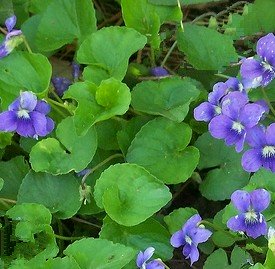
- Leaves are heart shaped attached to long petioles.
- Five petaled purple or blue flower with white centers.
- Spread by short, branching rhizomes.
- An extremely difficult plant to eliminate from lawns.
- Some herbicides have little to no effect.
Weed Identification
Wild violets are a hardy winter perennial that can be difficult to control once it is established. It is considered a weed in landscapes or in lawns. Although not recommended, if planted as ground cover, make sure there is a sound border system to prevent it from escaping or you may spend the next few years trying to control it. Wild violets grow from 2 to 5 inches tall with heart shaped leaves attached by long petioles. They remain green throughout the year, but can deteriorate quickly from ice or snow.
For weed identification, look for their flowers. They are most commonly a purple or blue, five petaled flower with white or yellow centers that sit atop a leafless stalk. The flowers usually appear from April to June.
The root system of mature plants is thick and fibrous. The plant spreads by producing short, branching rhizomes. (Underground stems) Wild violets prefer cool, moist, fertile and shady soil, but can tolerate sunny or dry climates as well.
Cultural controls
As stated above, wild violets are a persistent perennial that is very difficult to control. They can be removed by digging if all the roots and rhizomes are removed, otherwise they will grow back. The problem with pulling is that it usually only helps the plant to spread faster. The broken rhizomes become individual plants where you end up with more plants than you started with. Covering with black plastic for several months will provide a certain amount of control in serious cases.
Herbicide Use
The are two important things to consider: Use the right herbicide and know that it may take three or more years to get complete control.
The first year, one should expect to thin the number of plants in the lawn and prevent any further spreading. After that it requires persistence. Be sure to use no more herbicide than what is allowed. Adding more will not increase its effectiveness and may harm desirable plants.
Look for products containing Dicamba combined with 2,4-D. These two combinations are available to homeowners. Many herbicides come in three active ingredient combinations for best results. Other combinations are Dicamba with 2,4-DP, MCPP, MCPA. Some herbicides are not available to homeowners. Always follow label instructions completely.
Common Yarrow
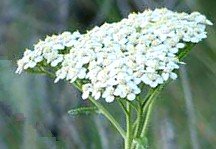
- A summer perennial.
- Leaves appear fern-like and are strongly scented.
- Forms white to pinkish flowers that grow in clusters.
- Spreads by seed and by rhizomes.
- Can be a sign of deteriorating soil quality.
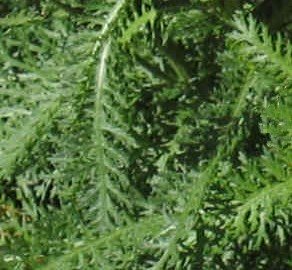
Weed Identification
For proper weed identification, look for a plant with fern-like leaves with sage-like aroma when crushed. The plant takes on a fern look due to its highly segmented leaves. The majority of leaves form at the base of the plant, similar to a rosette, but curve upward. They can reach lengths of 10 inches and are cover by small hairs.
In pastures or other areas that are not mowed, yarrow produces stems that can reach about 2 feet in height. The flowers are white and grow in flat-topped clusters. Each group consists of about 5 flowers surrounded by several disk flowers to form a cluster.
The roots of yarrow are somewhat fibrous. It spreads by forming multi-branched rhizomes and by seed. The seed can remain viable in the soil for approximately five years.
Yarrow is able to grow in many different types of soil including pastures, rocky fields, prairies, lawns and roadsides. It prefers areas with poor quality and thin soils where other plants have difficulty growing.
Cultural practices
Yarrow tends to grow in poor soil areas where other plants have a tough time growing in. The best method of keeping yarrow out of your yard is to have a thick, vigorous, and healthy soil. If you have yarrow growing in your yard, you can pull it up, but care should be taken to remove all of the roots and rhizomes. Seed left in the soil could germinate, but as you improve lawn conditions, the problems should go away. You should look at your soil quality and correct any problems. A healthy turf will keep yarrow out.
Herbicide use
Herbicide control is not necessary if lawn conditions are improved. However, for severe cases, using a formulation of Dicamba and 2,4-D will control it. Always follow label instructions carefully.
Crabgrass and Foxtails- Annual Grassy Weeds
Crabgrass and Foxtails are two major annual grassy weeds that can cover your lawn. You will find detailed information on their growth habits and how to stop them before they even start.
Winter Annual Broadleaf Lawn Weeds
The coming of spring also brings a surge in winter annual weeds. Here you can find helpful information on these difficult weeds, including photos, growth habits and methods of control.
Summer Annual Broadleaf Lawn Weeds
Summer annuals begin from seed in spring or summer and die at the first frost. Click here to learn more about these invasive weeds, including photos, growth habits and control methods.
Perennial Broadleaf Weed Identification Page 1
Click here for weed identification and control of common perennial lawn weeds. This page has detailed information on Canada Thistle, Mouseear Chickweed, White clover, Dandelion, Field Bindweed, Ground Ivy, and Common Mallow.
Yellow and Purple Nutsedge
Nutsedge is a summer perennial grass-like weed. They can be particular problematic since they cannot be controlled by broadleaf weed herbicides. Click here for weed identification, growth habits and control methods.
Weed Identification 2 to Lawn Care Academy Home



